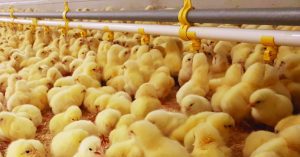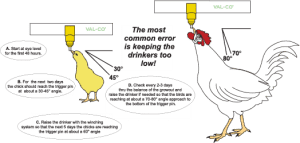Water is an important nutrient that directly affects a flock’s health and wellbeing. Birds must have adequate access to clean water for optimal consumption. It’s important to understand the difference between water usage and water consumption. Water usage is what goes through the water meter. It measures the water used for cooling systems, as well as the watering systems, but it doesn’t measure the exact amount consumed by the birds. Water consumption is what goes through the birds and is used for digestion and growth. Because it is impossible to know how much the birds are actually consuming, it’s imperative that the water is as consumable as possible.

First and foremost, there needs to be enough water supplied to the farm, whether from a well or from a public water source. Water supplies birds, but also cool cells, foggers, or sprinkler systems, so it is imperative that there is enough water, especially in hot weather.
Integrators generally have guidelines on how many gallons per minute the water supply must deliver. To know if you are meeting that requirement, you should know the size of the supply line from the well to the chicken house, and the size of the pump in the bottom of the well.
During peak season, houses require about 3 gallons per minute for drinking and 9 gallons per minute for cooling. A 2” supply line can move about 48-50 gallons per minute. Check that supply lines are sized appropriately for the amount of water that is needed and update them accordingly.
Once the supply is covered, we can start to measure usage and consumption. Water usage is what goes through the water meter. Digital water meters connected to controllers can monitor that usage on both a 24-hour basis, and in allotted time increments during the day, to help paint a clear picture of water usage and consumption by the birds.
Developing usage patterns specific to your farm and your equipment can alert you early on to potential problems that could cost you in the end. Water usage by the cooling system may remain relatively steady throughout warmer months, but usage by the birds may increase. There are critical high demand periods, such as when lights come on or sprinklers are running, that results in spikes of higher water usage. Overall usage should increase incrementally every few days. If usage remains unchanged, try to identify the cause. Are drinkers lines the right height? Are filters or drinkers clogged? Have there been changes in day length, light intensity, or illnesses?
Factors that may affect water consumption include bird age, environmental temperature, feeding and lighting programs, but most importantly, general maintenance. Birds must have constant, easy access to water, whenever they want it, which requires growers to keep the water lines clean, adjust their height and ensure the lines are level and water is flowing freely.
As birds age they consume more water, but overall consumption relative to bodyweight decreases. Drinker line height needs to be examined and adjusted almost daily. Today’s broilers grow exceptionally fast, and growers can’t afford to get behind with proper watering. The easiest way to determine if the height is suitable is to watch the birds. If they must sit to drink, it is too low. If they must stretch their necks straight up, stand on their toes, or hop, the line is too high.
 Here are some age guidelines to help you make appropriate adjustments:
Here are some age guidelines to help you make appropriate adjustments:
• Day-old chicks – drinkers should be just above eye level. Remember to have the barn lit well enough that the chicks are drawn to the shiny metal pin, so that they learn to drink from the nipples.
• 2 – 3 days – raise the lines so
chicks drink at a 30-45° angle.
• 4 – 10 days – raise lines so birds
are reaching at a 60° angle.
• 10 days through grow out – check frequently that birds are reaching at a 70 – 80° angle towards the bottom of the trigger pin.
If the environmental temperature is high, birds will consume more water, up to double or even triple the amount when heat stress occurs, up to 7% for each degree F increase in temperature. Water temperature can improve the performance of broilers and layers if the water temperature is below the body temperature of the bird.
During the hottest parts of the summer, flushing replaces the warmer water in the lines with fresher, cooler water. It encourages birds to drink more frequently and helps them regulate their body temperature more effectively.
Lighting programs also impact water consumption as houses with a lighting program see peak water consumption just after the lights come on and again to prior to the lights going out. This places a heavy demand on water pressure and can mean some birds are unable to gain access to a sufficient supply of water. On farms with multiple sheds, staggering the time when lights are on can reduce the sudden demand from the whole flock.
Water and feed consumption rates are interdependent. Reduced water intake leads to reduced feed intake and therefore reduced weight gain. If water is cool and clean and in the appropriate pH range, nipples are not prone to leaking and at the proper height for the birds’ age, we can safely track water usage through the meter and use its indications as a guideline for bird consumption.
Chickens prefer water with a pH of 6.0 to 6.8 but can tolerate a pH range of 4 to 8. A pH of less than 6 has been shown to negatively affect chicken performance, and water with a pH of over 8 may cause chickens to reduce their water consumption, leading to a negative effect on feed consumption and bird performance.
Flushing will help clean out biofilms from the watering lines, too. Biofilms can harbor bacteria that cause severe illnesses, and limiting their emergence means birds are more productive. Regular flushing helps to remove dirt or debris from the water lines and keep the nipple drinkers from being blocked. This ensures all your birds have access to all the water they need to turn feed into food.
Subscribe to our blog!
